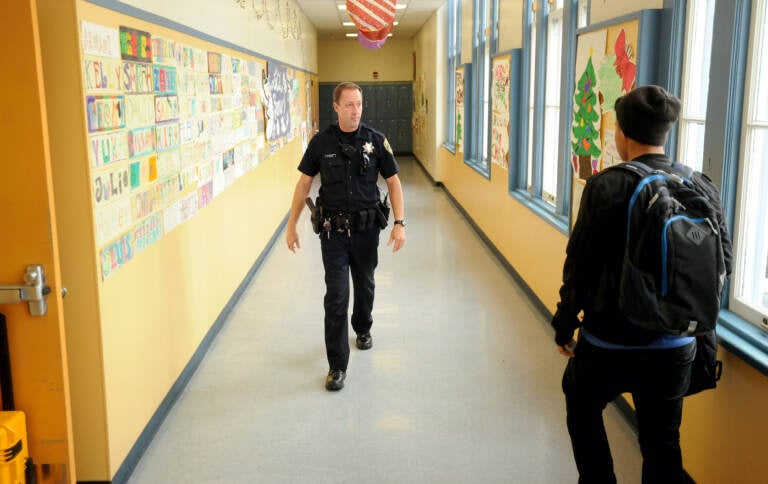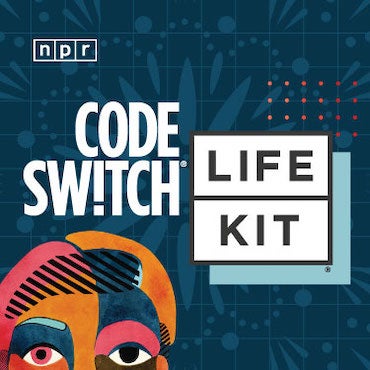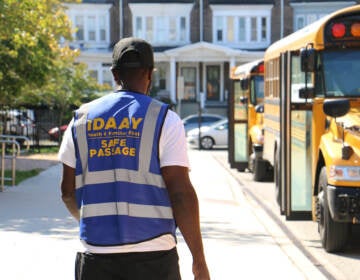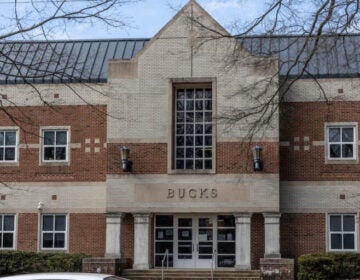School police don’t reduce gun possession or threats on campus, but they do lead to fewer fights, new study finds
The presence of school resource officers, sometimes called school police, comes with tradeoffs for Black students according to a new report.

File: In this Dec. 17, 2012 photo, Officer Rick Moore of the Oakland school district police patrols Oakland Technical High School in Oakland, Calif. (AP Photo/Noah Berger, File)
Police officers stationed on school campuses across the U.S. are reducing the number of fistfights and other aggressive behavior during the school day – but their presence also leads to more reports of gun possession and armed robbery on campus, according to a study released this month by the University at Albany.
The research compared elementary, middle, and high schools that use School Resource Officers (SROs) with those that did not. An SRO is a sworn officer employed by a law enforcement agency that’s assigned to police one or more schools. They are typically armed, according to the Pennsylvania Association of School Resource Officers.
The School District of Philadelphia has never had SROs according to district representatives. Instead, they employ unarmed school safety officers who work in and around schools and receive backup from Philadelphia Police Department officers.
These school safety officers used to be called “school police,” but the district changed the name and the duties of these employees in 2020 to comply with a new state requirement that only sworn officers could be called school police.The Philadelphia Student Union also circulated a petition calling for police-free schools at that time.
The students said they felt terrorized by the officers, and asked the district to “replace school police with community members trained in de-escalation, restorative justice, and other skills” according to the petition. District leadership vowed to make sure student interactions with school safety officers would be positive and helpful experiences.
School districts nationwide have been cutting back on their SRO programs over concerns about the disproportionate discipline of Black students, according to authors of the new University at Albany report.
In Philadelphia, there have been demands for more security on school campuses, especially following the fatal shooting of 14-year-old Nicolas Elizalde at Roxborough High in January. In April the School District of Philadelphia released data showing 100 students had been shot that school year, 20 of them fatally, according to CBS News Philadelphia.
In December, the district announced a gun violence prevention plan that includes hiring additional Philadelphia Police Department officers to “address safety issues outside of the school building that warrant an increased police presence,” using a $600,000 grant.
The study, which analyzed surveys conducted by the U.S. Department of Education Office for Civil Rights between 2014 and 2018, found that the presence of SROs “leads to undeniably harsher disciplinary punishments for students, and particularly for Black students, male students, and students with disabilities.”
The presence of SROs was linked to a 35% to 80% increase in out-of-school suspension, according to the authors.
Shawn Bushway, a University at Albany criminal justice professor, and study author, said that while SROs can’t suspend students, their presence does encourage school staff to administer more discipline.
“There was a sizable increase in suspensions, arrests when a school resource officer came to the schools, and those were concentrated among minorities,” Bushway said. “There’s this real tradeoff that has to be considered when bringing in a school resource officer, because there will be more negative outcomes.”
In Pennsylvania, students of color, students with disabilities, and students who identify or are perceived as LGBTQ are “more likely to face exclusionary school discipline (such as suspensions, expulsions, or disciplinary transfers) and/or contact with law enforcement,” than other students. These practices place children in the “school-to-prison pipeline,” according to a 2021 report of the Pennsylvania Advisory Committee to the U.S. Commission on Civil Rights.
The Pennsylvania Association of School Resource Association states on its website that well-trained school resources officers “do not arrest students for disciplinary issues that would be handled by teachers and/or administrators if the SROs were not there” and instead help young people avoid involvement with the juvenile justice system.
The University at Albany study did find that the presence of SROs reduces violent incidents without firearms, such as rape, attempted rape, and physical fights, by about 30%
But reports of gun-related offenses — which include possession, robbery, and threats but not shootings — increased by about 150% when SROs were present.
“It’s a little unclear whether that’s because there are more firearm offenses when there’s a school resource officer or because school resource officers are more focused on finding those events,” Bushway said.
He said districts that are considering investing in more school police should think about all of the possible consequences before increasing the presence of any type of officer.
In Philadelphia, school officials are expanding a Safe Paths program that hires community members to patrol school campuses and provide mentorship to teens. They’re also hoping to partner with community-based organizations to more effectively implement a youth diversion program designed to keep students out of jail, according to an action item from a late June budget meeting.
The Pennsylvania Association of School Resource Officers will hold a conference in Harrisburg at the end of July.
Editor’s note: This story has been updated to provide context for the change in how the Philadelphia School District refers to school safety officers.

Get daily updates from WHYY News!
WHYY is your source for fact-based, in-depth journalism and information. As a nonprofit organization, we rely on financial support from readers like you. Please give today.







